Fran Baker's Blog, page 13
June 20, 2012
Wednesday, June 20, 1934
Went street car riding. Went swimming with Pauline today. Sure is hot. Today was Pauline's birthday.
 Community Christian Church
Community Christian Church
46th and Main Streets, Kansas City, Missouri
Designed by Frank Lloyd Wright
The “Steeple of Light” illuminated beams are visible Fridays, Saturdays
and Sundays from dark until midnight.

 Community Christian Church
Community Christian Church46th and Main Streets, Kansas City, Missouri
Designed by Frank Lloyd Wright
The “Steeple of Light” illuminated beams are visible Fridays, Saturdays
and Sundays from dark until midnight.
Published on June 20, 2012 04:45
June 19, 2012
Tuesday, June 19, 1934
Today was Helen's birthday. She is 12 years old. Went to Swope Park. I caught 3 fish. Made ice cream.
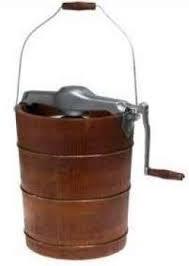 This is a manual or "old-fashioned" ice cream maker. The milk mix is surrounded by ice and mixed by turning the handle until it freezes gently.
This is a manual or "old-fashioned" ice cream maker. The milk mix is surrounded by ice and mixed by turning the handle until it freezes gently.
In the 1930s, homemade ice cream became a big trend in kitchens across America because the “mechanical icebox”, or refrigerator, began to see widespread use.
Homemade Vanilla Ice Cream Recipe
Ingredients:
•2 1/2 Cups milk, half-n-half, light cream or a blend
•1/2 Cup sugar
•a pinch of salt
•3 Tbsp corn starch
•vanilla bean, vanilla paste or extract
Cooking Directions:
1.Pour 2 of the cups of milk/cream into a pot and put over medium heat. Blend in the sugar and the pinch of salt. If you are using whole vanilla bean, now is when you add the beans and pod to the milk mixture. Heat gently until the mixture is steaming slightly. Then strain out the bean pod.
2.In another bowl, mix the last 1/2 cup of milk/cream and the cornstarch. Blend or whisk until there are no lumps. Then add this mixture to the sweetened milk, whisking frequently and heat until the mixture is almost boiling. Reduce heat and simmer for 5 minutes, whisking mixture as it thickens. If you are using vanilla paste or extract, add it after the mix gets thick.
3.Remove thickened milk from heat and allow to cool (this can take several hours). You get better freezing from using a cooled-down mixture. Once milk mix is cold, pour it into your ice cream mixer and freeze according to the instructions for the mixer. (This step can take a half hour to several hours.)

 This is a manual or "old-fashioned" ice cream maker. The milk mix is surrounded by ice and mixed by turning the handle until it freezes gently.
This is a manual or "old-fashioned" ice cream maker. The milk mix is surrounded by ice and mixed by turning the handle until it freezes gently.In the 1930s, homemade ice cream became a big trend in kitchens across America because the “mechanical icebox”, or refrigerator, began to see widespread use.
Homemade Vanilla Ice Cream Recipe
Ingredients:
•2 1/2 Cups milk, half-n-half, light cream or a blend
•1/2 Cup sugar
•a pinch of salt
•3 Tbsp corn starch
•vanilla bean, vanilla paste or extract
Cooking Directions:
1.Pour 2 of the cups of milk/cream into a pot and put over medium heat. Blend in the sugar and the pinch of salt. If you are using whole vanilla bean, now is when you add the beans and pod to the milk mixture. Heat gently until the mixture is steaming slightly. Then strain out the bean pod.
2.In another bowl, mix the last 1/2 cup of milk/cream and the cornstarch. Blend or whisk until there are no lumps. Then add this mixture to the sweetened milk, whisking frequently and heat until the mixture is almost boiling. Reduce heat and simmer for 5 minutes, whisking mixture as it thickens. If you are using vanilla paste or extract, add it after the mix gets thick.
3.Remove thickened milk from heat and allow to cool (this can take several hours). You get better freezing from using a cooled-down mixture. Once milk mix is cold, pour it into your ice cream mixer and freeze according to the instructions for the mixer. (This step can take a half hour to several hours.)
Published on June 19, 2012 04:45
June 18, 2012
Monday, June 18, 1934
Aunt Kate and Helen came here. Helen and I went swimming as Grove opened today. They ate supper here.
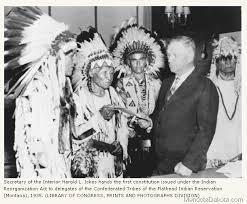 Indian Reorganization Act
Indian Reorganization Act
The Indian Reorganization Act of June 18, 1934, sometimes known as the Indian New Deal, was U.S. federal legislation that secured certain rights to Native Americans (known in law as American Indians or Indians), including Alaska Natives.
These include actions that contributed to the reversal of the Dawes Act's privatization of communal holdings of American Indian tribes and a return to local self-government on a tribal basis. The Act also restored to Indians the management of their assets (being mainly land) and included provisions intended to create a sound economic foundation for the inhabitants of Indian reservations.
The act did not require tribes to adopt a constitution. But, when a tribe chose to do so, the constitution had to:
1.allow the tribal council to employ legal counsel;
2.prohibit the tribal council from engaging in any land transactions without majority approval of the tribe; and,
3.authorize the tribal council to negotiate with the Federal, State, and local governments.

 Indian Reorganization Act
Indian Reorganization ActThe Indian Reorganization Act of June 18, 1934, sometimes known as the Indian New Deal, was U.S. federal legislation that secured certain rights to Native Americans (known in law as American Indians or Indians), including Alaska Natives.
These include actions that contributed to the reversal of the Dawes Act's privatization of communal holdings of American Indian tribes and a return to local self-government on a tribal basis. The Act also restored to Indians the management of their assets (being mainly land) and included provisions intended to create a sound economic foundation for the inhabitants of Indian reservations.
The act did not require tribes to adopt a constitution. But, when a tribe chose to do so, the constitution had to:
1.allow the tribal council to employ legal counsel;
2.prohibit the tribal council from engaging in any land transactions without majority approval of the tribe; and,
3.authorize the tribal council to negotiate with the Federal, State, and local governments.
Published on June 18, 2012 04:45
June 17, 2012
Sunday, June 17, 1934
Didn't go to church or Sunday school today. In the evening Ollie came over. Played pinochle.
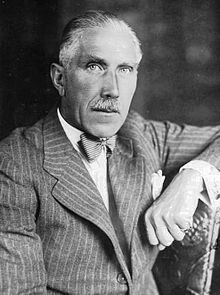 Lieutenant-Colonel Franz Joseph Hermann Michael Maria von Papen zu Köningen
Lieutenant-Colonel Franz Joseph Hermann Michael Maria von Papen zu Köningen
(29 October 1879 – 2 May 1969)
The Marburg Speech (German: Marburger Rede) was an address given by German vice chancellor Franz von Papen at the University of Marburg on June 17, 1934. It is said to be the last speech made publicly, and on a high level, in Germany against Nazism.
Papen, encouraged by President Paul von Hindenburg, spoke out publicly about the excesses of the Nazi regime, whose ascent to power, 17 months earlier when Adolf Hitler became chancellor of Germany, had been assisted measurably by Papen. In his speech von Papen called for an end of the Nazi terror and the clamoring for a "second revolution" by the Sturmabteilung (SA – the Nazi Party storm troopers), and a return to dignity and freedom. He also stated: "The government [must be] mindful of the old maxim 'only weaklings suffer no criticism'".
The speech made Hitler furious, and propaganda minister Joseph Goebbels attempted to suppress it. Angered by the blocking of publication of his speech, Papen insisted he had spoken on behalf of Hindenburg, threatened to submit his resignation from Hitler's cabinet, and promised to inform Hindenburg of the suppression of his speech.
Papen resigned as vice chancellor; he would later serve as a diplomat until 1944, and played no further political role.

 Lieutenant-Colonel Franz Joseph Hermann Michael Maria von Papen zu Köningen
Lieutenant-Colonel Franz Joseph Hermann Michael Maria von Papen zu Köningen (29 October 1879 – 2 May 1969)
The Marburg Speech (German: Marburger Rede) was an address given by German vice chancellor Franz von Papen at the University of Marburg on June 17, 1934. It is said to be the last speech made publicly, and on a high level, in Germany against Nazism.
Papen, encouraged by President Paul von Hindenburg, spoke out publicly about the excesses of the Nazi regime, whose ascent to power, 17 months earlier when Adolf Hitler became chancellor of Germany, had been assisted measurably by Papen. In his speech von Papen called for an end of the Nazi terror and the clamoring for a "second revolution" by the Sturmabteilung (SA – the Nazi Party storm troopers), and a return to dignity and freedom. He also stated: "The government [must be] mindful of the old maxim 'only weaklings suffer no criticism'".
The speech made Hitler furious, and propaganda minister Joseph Goebbels attempted to suppress it. Angered by the blocking of publication of his speech, Papen insisted he had spoken on behalf of Hindenburg, threatened to submit his resignation from Hitler's cabinet, and promised to inform Hindenburg of the suppression of his speech.
Papen resigned as vice chancellor; he would later serve as a diplomat until 1944, and played no further political role.
Published on June 17, 2012 04:45
June 16, 2012
Saturday, June 16, 1934
Daddy got a day job over on Garfield.
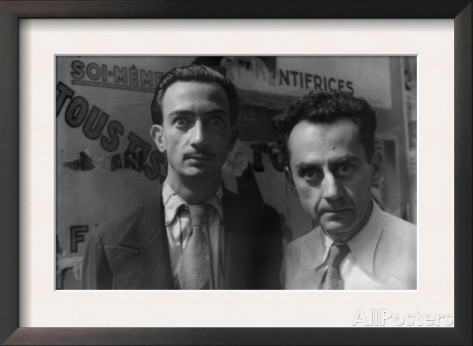 Salvador Dali and Man Ray
Salvador Dali and Man Ray
Paris, France
June 16, 1934
Man Ray (born Emmanuel Radnitzky) (August 27, 1890 – November 18, 1976)
was an American artist who spent most of his career in Paris, France. Described
as a modernist, he was a significant contributor to both the Dada and Surrealist
movements; although his ties to each were informal. Best known in the art world
for his avant-garde photography, Ray produced major works in a variety of media
and was a renowned fashion and portrait photographer, even though he considered himself a painter above all. Ray is also noted for his work with photograms, with the artist coining the term "Rayographs" in reference to himself
 Salvador Dali and Man Ray
Salvador Dali and Man RayParis, France
June 16, 1934
Man Ray (born Emmanuel Radnitzky) (August 27, 1890 – November 18, 1976)
was an American artist who spent most of his career in Paris, France. Described
as a modernist, he was a significant contributor to both the Dada and Surrealist
movements; although his ties to each were informal. Best known in the art world
for his avant-garde photography, Ray produced major works in a variety of media
and was a renowned fashion and portrait photographer, even though he considered himself a painter above all. Ray is also noted for his work with photograms, with the artist coining the term "Rayographs" in reference to himself
Published on June 16, 2012 04:45
June 15, 2012
Friday, June 15, 1934
NOTE: Ruth did not write in her diary today.
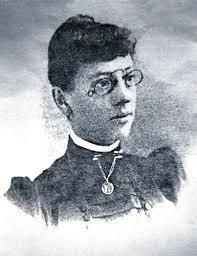 Annie White Baxter (1864-1944)
Annie White Baxter (1864-1944)
Born in Pennsylvania, she moved with her parents to southwest Missouri, residing in both Carthage and Joplin. Her father was the operator of a Carthage furniture factory with a better than average income. Thus Annie was accustomed to the good life, a gracious home and the admiration of her fellow students. At Carthage High School, where she graduated in 1882, she was said to be the most outspoken, most aggressive and most commanding person in her class.
Following graduation, she obtained employment at the Jasper County Courthouse and eventually became the chief deputy county clerk. In 1888, she married Charlie Baxter, a dry goods clerk at the R.H. Rose Department Store. In 1890, although no woman yet could vote in Missouri, she was elected county clerk. This was the first time a woman had been elected county clerk in the United States. In that office, she was among the county officials involved in planning and overseeing construction of the present courthouse, which was completed in 1895.

 Annie White Baxter (1864-1944)
Annie White Baxter (1864-1944)Born in Pennsylvania, she moved with her parents to southwest Missouri, residing in both Carthage and Joplin. Her father was the operator of a Carthage furniture factory with a better than average income. Thus Annie was accustomed to the good life, a gracious home and the admiration of her fellow students. At Carthage High School, where she graduated in 1882, she was said to be the most outspoken, most aggressive and most commanding person in her class.
Following graduation, she obtained employment at the Jasper County Courthouse and eventually became the chief deputy county clerk. In 1888, she married Charlie Baxter, a dry goods clerk at the R.H. Rose Department Store. In 1890, although no woman yet could vote in Missouri, she was elected county clerk. This was the first time a woman had been elected county clerk in the United States. In that office, she was among the county officials involved in planning and overseeing construction of the present courthouse, which was completed in 1895.
Published on June 15, 2012 04:45
June 14, 2012
Thursday, June 14, 1934
Today was Flag Day.
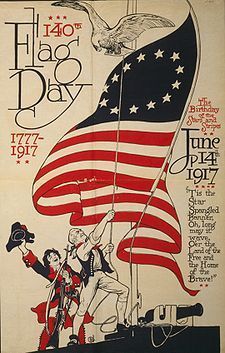 Poster commemorating the 140th Flag Day on June 14, 1917
Poster commemorating the 140th Flag Day on June 14, 1917
It commemorates the adoption of the flag of the United States, which happened that day
by resolution of the Second Continental Congress in 1777.
In 1916, President Woodrow Wilson issued a proclamation that officially established
June 14 as Flag Day; in August 1949, National Flag Day was established by an Act of Congress.

 Poster commemorating the 140th Flag Day on June 14, 1917
Poster commemorating the 140th Flag Day on June 14, 1917It commemorates the adoption of the flag of the United States, which happened that day
by resolution of the Second Continental Congress in 1777.
In 1916, President Woodrow Wilson issued a proclamation that officially established
June 14 as Flag Day; in August 1949, National Flag Day was established by an Act of Congress.
Published on June 14, 2012 04:45
June 13, 2012
Wednesday, June 13, 1934
NOTE: Ruth didn't write in her diary today.
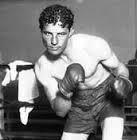 Maximilian "Max" Adelbert Baer (February 11, 1909 – November 21, 1959)
Maximilian "Max" Adelbert Baer (February 11, 1909 – November 21, 1959)
Heavyweight Champion of the World
On June 14, 1934, Baer, after knocking him down 11 times, won by Technical knock out over the massive, 275-pound (125-kg) Primo Carnera, Heavyweight Champion of the World, to win the world title, which he would hold for 364 days.

 Maximilian "Max" Adelbert Baer (February 11, 1909 – November 21, 1959)
Maximilian "Max" Adelbert Baer (February 11, 1909 – November 21, 1959) Heavyweight Champion of the World
On June 14, 1934, Baer, after knocking him down 11 times, won by Technical knock out over the massive, 275-pound (125-kg) Primo Carnera, Heavyweight Champion of the World, to win the world title, which he would hold for 364 days.
Published on June 13, 2012 04:45
June 12, 2012
Tuesday, June 12, 1934
Straightened up the house today. Mother ironed.
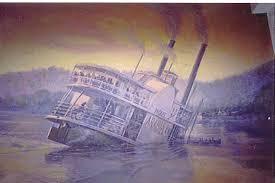 The Great White Arabia Steamship - 1856
The Great White Arabia Steamship - 1856
In 1856, the Great White Arabia steamship went down, felled ultimately by a snag from a walnut tree in
the Mighty Missouri River. In 1988, she began to come up, saved by five families determined to excavate
and preserve her cargo.
The Steamboat Arabia Museum, in the City Market downtown, tells the story of what river travel and westward expansion looked like in the mid-1800s and showcases settlers’ near-perfectly preserved artifacts — Wedgwood china, shoes, boots, clothing, weapons, razors, doorknobs and more.

 The Great White Arabia Steamship - 1856
The Great White Arabia Steamship - 1856In 1856, the Great White Arabia steamship went down, felled ultimately by a snag from a walnut tree in
the Mighty Missouri River. In 1988, she began to come up, saved by five families determined to excavate
and preserve her cargo.
The Steamboat Arabia Museum, in the City Market downtown, tells the story of what river travel and westward expansion looked like in the mid-1800s and showcases settlers’ near-perfectly preserved artifacts — Wedgwood china, shoes, boots, clothing, weapons, razors, doorknobs and more.
Published on June 12, 2012 04:45
June 11, 2012
Monday, June 11, 1934
Daddy called up home (Clay Center, Kansas). Mother talked to Aunt Minnie.
 1930s Telephone
1930s Telephone
The number of local telephone conversations grew 46.8 percent between 1920 and 1930, while the number of long distance conversations grew 71.8 percent over the same period. There were 5 times as many long distance telephone calls as telegraph messages handled in 1920, and 5.7 times as many in 1930. the share of all households with a telephone rose from 35 percent to nearly 42 percent. In cities across the nation, AT&T consolidated its system, gained control of many operating companies, and virtually eliminated its competitors. It was able to do this because in 1921 Congress passed the Graham Act exempting AT&T from the Sherman Act in consolidating competing telephone companies.

 1930s Telephone
1930s TelephoneThe number of local telephone conversations grew 46.8 percent between 1920 and 1930, while the number of long distance conversations grew 71.8 percent over the same period. There were 5 times as many long distance telephone calls as telegraph messages handled in 1920, and 5.7 times as many in 1930. the share of all households with a telephone rose from 35 percent to nearly 42 percent. In cities across the nation, AT&T consolidated its system, gained control of many operating companies, and virtually eliminated its competitors. It was able to do this because in 1921 Congress passed the Graham Act exempting AT&T from the Sherman Act in consolidating competing telephone companies.
Published on June 11, 2012 04:45



